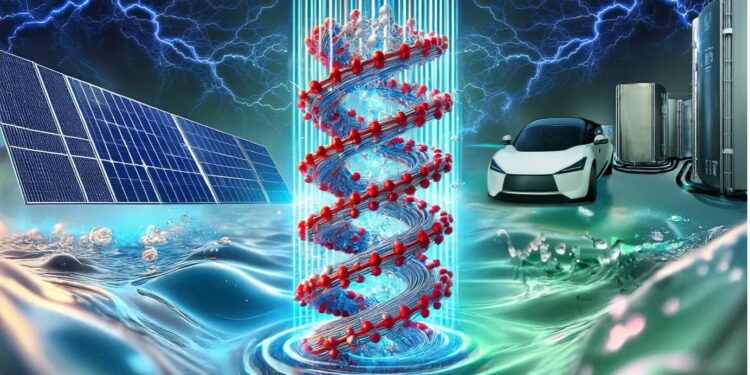Credit: OpenAI Dall-E.
Electrocatalytic water splitting, a process that involves splitting water into hydrogen and oxygen, is a promising approach to producing clean hydrogen for fuel cells, which in turn could be used to power large electric vehicles. Until now, actual use of this process has been limited by the slow kinetics of the oxygen evolution reaction (OER), a key chemical reaction occurring at the anode.
Researchers at the Max Planck Institute for Chemical Physics of Solids, the Weizmann Institute of Science and other institutes have recently introduced an innovative approach to accelerate this reaction, using topological chiral semimetals as electrocatalysts.
Their findings, published in Natural energydemonstrate that the spin-orbit coupling (SOC) inherent in these materials can be exploited to stimulate OER activity, thereby facilitating more efficient electrocatalytic water splitting.
“Our research was driven by the pressing need for clean and sustainable energy solutions,” Xia Wang, first author of the paper, told Tech Xplore.
“Specifically, we aimed to address the challenge of improving electrocatalytic water splitting for hydrogen production, with a focus on OER, a critical step often hampered by slow kinetics. Inspiration came from the distinctive electron transport properties of topological chiral semimetals, which offered a promising avenue to address the limitations of traditional catalysts.
The main goal of the recent study by Wang and colleagues was to exploit the quantum properties of topological chiral semimetals to improve the efficiency of OERs. To achieve this, the team first synthesized a series of topological chiral Rh-based semimetals with different SOC strengths, including RhSi, RhSn, and RhBiS.
“These materials exhibit both highly ordered geometric chirality and electronic chirality, which enable the generation of spin-polarized carriers, essential for enhancing catalytic activity,” Wang explained.
“By comparing their performance to that of achiral reference materials, we demonstrated that chiral crystals significantly outperform state-of-the-art catalysts, such as RuO2achieving up to two orders of magnitude higher specific activity in alkaline electrolytes.
The results assembled by Wang and colleagues reveal a direct link between SOC strength in topological chiral semimetals, spin polarization, and catalytic activity of the materials. This important discovery could guide future design of electrocatalysts for water splitting, leading to the identification of topological materials driving optimal OER activity.
“The most notable achievement of our study is the experimental validation of a direct link between SOC and OER performance, establishing a robust design principle for spin-dependent catalysts,” Wang said. “Among the materials we studied, RhBiS proved to be a remarkable performer, demonstrating remarkable REL activity, with specific activity far exceeding that of conventional catalysts.”
The recent work of this team of researchers could ultimately help accelerate the development of advanced water separation technologies. This in turn could facilitate the adoption of hydrogen-based green energy solutions, including fuel cells to power planes, trucks and other large electric vehicles.
“This work lays the foundation for using spin-orbit coupling as a tool to design more efficient topological catalysts,” said Professor Maggie Lingerfelder of EPFL, an expert in the field.
“In my opinion, spin-orbit coupling is an under-explored aspect in the design of selective catalysts, but it could potentially explain why Pt exhibits such versatile catalytic behavior in various reactions. This work opens exciting avenues for further exploration future, because it brings the solid state physics community closer to the applications of chiral topological materials in spin-controlled chemistry.
In their next studies, Wang and his colleagues plan to build on their findings, expanding their search to other topological materials with different electronic and magnetic properties. This could allow them to further optimize the generation of spin-polarized carriers.
“We also plan to focus on real-world applications by developing scalable and cost-effective catalysts and evaluating their performance in relevant industrial settings,” Wang added.
“By bridging the gap between fundamental research and practical implementation, we hope to contribute significantly to the advancement of sustainable energy technologies.”
More information:
Xia Wang et al, Topological semimetals with intrinsic chirality as spin-controlling electrocatalysts for the oxygen evolution reaction, Natural energy (2024). DOI: 10.1038/s41560-024-01674-9.
© 2024 Science X Network
Quote: Harnessing spin: new electrocatalysts could transform hydrogen production efficiency (2024, December 16) retrieved December 17, 2024 from
This document is subject to copyright. Except for fair use for private study or research purposes, no part may be reproduced without written permission. The content is provided for informational purposes only.



